Rock Island’s Circa ’21 Premieres Filmed Bluegrass Musical From Feb. 6 to 28
In a dark, uncertain time, Circa ’21 offers light and unadulterated joy in its latest online entertainment, the fun bluegrass musical “Big Rock Candy Mountain.”
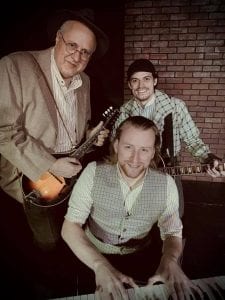
The “Big Rock” stage band features Doug Kutzli, left, Bobby Becher (piano) and Anthony Natarelli.
Fans of the film “O Brother Where Art Thou” and the Circa ’21 favorite “Southern Crossroads” should love this original musical – written and directed by Tristan Tapscott — that features such classic hits as “Big Rock Candy Mountain,” “House of the Rising Sun,” “Keep on the Sunny Side of Life” and many more.
In the story set in 1932, a merry band of misfits sneaks into a theater hoping to stay out of trouble, but instead finds themselves front and center in a tale about the power of music and second chances. The small cast includes a down-on-her-luck theater owner, her wacky assistant, a clueless town mayor, his scheming wife and a bumbling sheriff.
Tapscott – a Circa ’21 veteran – premiered the musical in 2014 at his former District Theatre in Rock Island, and it played many times after that (including the Speakeasy in early 2015). He said it’s an ideal time to bring back now, filmed in the Speakeasy without an audience, and launching online starting Saturday, Feb. 6.
“I think it’s the perfect show for right now, because it warms your soul in a lot of ways,” he said this week. “Between the cold and the pandemic and everything else, I think a feel-good bluegrass show is what we need. And there’s some heart to it. It’s not necessarily all fun and games the entire time. But, it’s also one of those shows that’s in and out – we do our beginning, middle and our end, and we let the audience leave, or in this case shut off their televisions.”
“We don’t dwell on anything too much. The music’s great, and in a way, to sit and enjoy something and not to have to think about all the craziness that we’re going through is a welcome thing right now.”
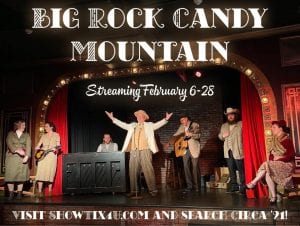
“Big Rock Candy Mountain” will be available to stream Feb. 6 to 28.
The “Big Rock” cast includes two performers who were in its debut – Doug Kutzli and Anthony Natarelli – as well as Ashley and Bobby Becher, Janos Horvath, Shelley Cooper, Savannah Bay Strandin and Mike Turczynski.
Kutzli plays King, the band leader; Bobby Becher is Levi, the piano player; Natarelli is Walt, the guitar player; Ashley Becher is Georgia, the theater owner, and Strandin is Claudia, the handy woman; Turczynski is Willie, the dopey sheriff; Horvath is the mayor and Cooper is his cruel wife.
Khalil Hacker was the cinematographer and editor for the 85-minute production – which had just three rehearsals and two long days of filming in the Circa Speakeasy. He’s worked a lot over the past year in putting together other Circa streamed shows, as well as Natarelli’s “Lonely Planet” last September – which he acted in his apartment with Turczynski. Hacker said he and the rest of the group are thrilled with how “Big Rock” turned out.
“I’ve been really happy to do something that’s moving this format forward, whether it be with Tristan or Anthony Natarelli,” he said. “I feel like both of them have done a lot in the area to help move local theater a little more towards streaming. It’s really nice to have this during a time when we can’t be together safely, but I think also this will help a lot of people who don’t normally go out to the theater, to get to experience this for the first time.
“It’s been an honor to be part of this borderline revolutionary thing that’s been happening, whether we were forced into it or not. I’ve been diggin’ it. It’s been a lot of fun, plus it’s been keeping me sane.”
Tapscott said streaming shows over the past year has been a learning experience.
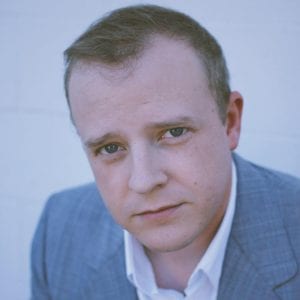
Tristan Tapscott wrote the script and directed the new production.
“When we started to do these virtual cabarets, we didn’t know what it was. We didn’t know what the virtual format was going to be, and because of all the experience we had – from the spring until now – has brought us to this, where we understand that it’s a hybrid of a theater and film piece. It’s not one or the other; it’s somewhere in the middle.”
“It’s going to be one of those things that can reach people who normally wouldn’t come see something like this, but it might just spark their curiosity enough to get involved.”
Kutzli – who plays guitar in the show – reworked the original Danny White musical arrangements for the show, and they pre-recorded the music for the new film version.
“One of our intentions was to downsize the cast a little bit, to give that safe distance feel to the show, because that’s the climate we live in,” he said. “Instead of having a stand-up bass and a couple extra musicians, we had a guitar, a mandolin and a piano player.”
One of the reasons it was so popular was, there was a reason the songs happened when they did in the script, Kutzli said. “The music is kind of the whole crux, that drives the whole show along,” he said.
“In a weird way, some of the songs really help inform and propel the story along – which you normally don’t get when you throw a bunch of songs together,” Tapscott said. “It’s not a jukebox show, but it is.”
This is his favorite version of the show, including his favorite cast.
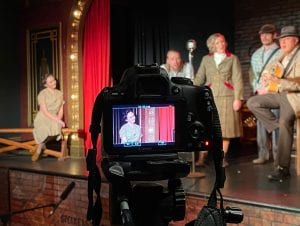
Khalil Hacker’s camera focuses on Savannah Bay Strandin.
“Everything seemed to work so well, which is mind-boggling to me, because we only had four rehearsals total to put this together, which is also bonkers,” Tapscott said. “The band had been playing for a number of years by the time we introduce them in the show, and I’m not kidding – I’d buy it. It was so natural and the cast seemed to work so well together. In a weird way, it was so easy to put together.
“I got A-listers, which was helpful,” he said of the cast. Besides Kutzli, just Anthony Natarelli is from the original 2014 cast, and the character he played is now embodied by a female, Savannah Bay Strandin.
Strandin is assistant to the theater owner, played by Ashley Becher. That’s also unusual, since women probably wouldn’t have been in that position in 1932.
“But it really works well, and the dynamic of it, with the band and some of the other characters work so well together – those characters are just gonna remain where they are now,” Tapscott said.
Inspired by hobos, “Crossroads” and “O Brother”
The origins of “Big Rock” date back to 2011, when Tapscott read about a town in Iowa that has a hobo convention every year (Britt Hobo Days), including music.

Tristan Tapscott (at left holding drumsticks) was in the original 2012 Circa cast of “Southern Crossroads.”
Since 1900, the city of Britt, Iowa (four hours drive from Davenport) has been hosting a National Hobo Convention, and boasts a National
Hobo Museum.
“I always thought, wouldn’t it be cool to do a show about that?” Tapscott said this week. He shelved it, and started writing a new version of “A Christmas Carol” (with music and lyrics by Danny White), which the District premiered in December 2012.
When Tapscott was in “Southern Crossroads” at Circa ’21 (in 2012 and 2013), he wanted to revisit his hobo story, and watched “O Brother Where Art Thou” (2000) one night, which inspired him further.
“It was an amalgam of being in ‘Crossroads’ at the time, watching ‘O Brother’ and all of these influences from like ‘The Muppet Movie’ – so it was an amalgam of my top three favorite things in 2011 and ’12,” he said. “It kind of became its own thing.”
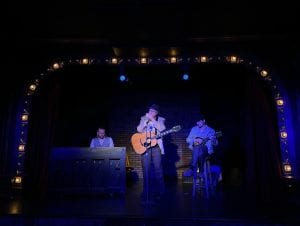
Bobby Becher, left, Doug Kutzli, and Anthony Natarelli performing in “Big Rock Candy Mountain.”
“Southern Crossroads” – first done at Circa in March 2012 – was originally produced in 2009 at the Wayside Theatre in Middletown, Va. It’s a heartfelt, high-spirited salute to some of the most beloved bluegrass, country and gospel songs in American history, including “Keep on the Sunny Side,” “I’ll Fly Away,” “Midnight Special,” “Way Downtown” and “Mountain Dew” — a bountiful 29 tunes altogether.
That story follows a traveling family of singers and musicians that arrives at its new gig in Virginia to find the doors locked and the aptly named New Hope Theatre out of business. The plucky, optimistic performers need money for train fare, so they decide to play for the townspeople passing by (otherwise known as the people in the audience), hoping to earn tips.
Some songs are the same between “Big Rock” and “Southern Crossroads,” and the creator of the latter, Warner Crocker, saw “Big Rock” and asked Tapscott to throw in the name of the family singers from “Crossroads.” In “Big Rock,” there’s a nice moment when they acknowledge picking up a song from the Greene Family Singers.
“I think it’s such a sweet little show, and I love ‘Crossroads’ too, and I hope Circa picks up more of those gospel shows,” Tapscott said. “They’re all fantastic.”
The reason he finished “Big Rock,” the District was struggling financially then, had to cancel some shows, and if he did an original show, he wouldn’t have to pay for rights, and it became a big hit.

The cast filmed the show at the Speakeasy over two 12-hour days.
“That show saved the District at the time, and within this show, this band is saving this theater,” Tapscott said. “Right now, we’re doing our best to save Circa ’21, so it works on so many different levels right now, it’s kind of weird.”
“Big Rock” has been done more often than his “Christmas Carol,” because it’s much easier to do, he said. “Big Rock is a show, it’s like the show that never dies. I thought six years ago, when the theater shut down, we’ll never see that show again. And here we are, so you never know.”
Kutzli (who’s played Scrooge in Tapscott’s “Christmas Carol”) said he’s often gotten questions from people in past years wondering if “Big Rock” was coming back.
“Out of the 100 or shows I’ve produced in my life, this is the show people ask me about the most,” Tapscott said. “It has a nice shelf life. It’s good time and people love it.”
Reflections from “Big Rock” opening
“Big Rock” originally centered on a band with a deep secret (the guys are escaped convicts), in a small-town theater, where they must pose as the Good Ole Boys Bluegrass Band to outrun the law and save the joint from the crazed mayor taking over the town. What unfolds is an “inspiring story of hope and the magic of music,” Tapscott said in 2014, noting there are about 20 familiar songs.
“We’re not pretending we revolutionized theater. It’s just a really good time at the theater, really funny,” he said then. “It’s music everyone
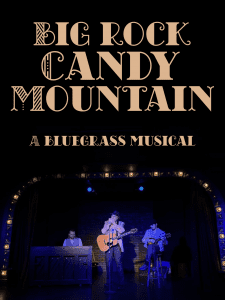
Tapscott’s Depression-era bluegrass musical premiered in 2014 at his former District Theatre.
knows. The key for us on this project was to have a good ole time and enjoy every minute of it.”
In “Big Rock Candy Mountain” (named for a famous folk song, first recorded in 1928, about a hobo’s idea of paradise), the bluegrass band is the house band and the District became its theater, with the audience involved in the show.
Tapscott was artistic director of the former District – which began life in 2008 as the Harrison Hilltop Theatre at 1601 Harrison St., Davenport. In 2011, it moved to the former Brew & View — later the Green Room — at 1611 2nd Ave., Rock Island, before moving down the block in August 2014 to the long and narrow former Grape Life space at 1623 2nd Ave. The District last operated at the former Argus building, 1724 4th Ave., Rock Island, in 2015-16.
“I loved the show the first time around,” Kutzli said. “I made a vague Facebook post in the world, to Tristan, before this ever happened, saying I really wanted to be in a show where I could find things I really liked to do – which was play guitar and act, and his response to me at the time was, I think I might have something in the works,” he said.
Coming back to it was hard because it wasn’t going to be like the first time, Kutzli said. “There’s no way that it can be; I’m older now, there’s different people now. Revisiting the songs was really easy.”
“It worked out great. We sounded really good together,” he said.
In 2014, Tapscott also wanted something family-friendly, since that was fairly rare at The District, and fit the lighter summer season. “It’s
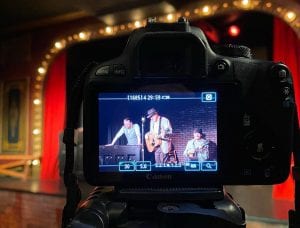
Focusing on the “Big Rock” band during filming.
nothing too philosophical, just a really good time,” he said.
“The music kind of lends itself to the Depression,” he said. “The theater owner in the show helps entertain the audience, talks about how difficult the times are. It’s a period I’m attracted to, aesthetically, the way it looks,” Tapscott said, adding it was also relevant to the tough economic times of the present day – which connects in a different way to a pandemic-struck 2021.
Challenges and joys in no audience, filming
Performing without an audience was interesting, since it’s normally an interactive show with the audience, Kutzli said, noting characters speak directly to the crowd.
“The audience was always sort of the other character in the show,” he said. “To do this with the illusion that there was someone sitting in the dark was, I wouldn’t say difficult, but it was something I had to get used to. Doing some other streaming things in the past few months has helped with that some. It wasn’t as awkward once we got rolling, as I thought it was going to be. It sure is nice to have applause though; nice to have people laughing when you say something funny.”
Tapscott said when people watch it at home, it will seem a lot less weird, like a sitcom.
He said this will be how theater will be consumed in the future, noting Broadway’s “Come From Away” will be filmed and streamed in September.

“Big Rock Candy Mountain” features Ashley Becher, left, Savannah Bay Strandin, Bobby Becher, Janos Horvath, Doug Kutzli, Mike Turczynski, and Shelley Cooper.
“I’d like to say Khalil and I are a little ahead of the curve, as usual,” Tapscott said. “I don’t count ‘Hamilton,’ because they filmed that in 2016.”
Like any major movie musical, Hacker filmed “Big Rock” scene by scene, with multiple takes, and pre-recorded the vocals and instruments.
“With that visually, we can get a lot more creative,” he said. “We can have stylized shots, which we don’t have to stress getting it perfectly right on the day, and if we missed it, we missed it.”
“It was literally half film, half theater,” Hacker said.
“It took a bunch of stress off the band, but the opportunity to go, we didn’t do that as good as we could have,” Kutzli said. “It took the stress off being perfect the first time through. We had that safety net.”
Hacker could see the performers were having much more fun. “I feel like the way we did this, without the stress of doing it live, perfect, you can really feel that everyone’s having a good time – which hopefully will make everyone else have a good time.”
“You can see in their eyes, they’re believing what they’re doing,” Tapscott said. “There’s no stress, we have to get this note and this note. In theater live, you have to worry about 80 different things at the same time…In a film, because of the way we did it, the actors were able to stay in a moment and believe in that moment. You can tell, because they weren’t worried, God, what comes next, because they know we’re just filming this singular moment in time.”
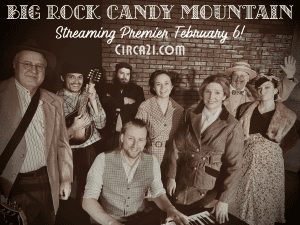
The bluegrass musical, filmed at the Speakeasy, premieres on Saturday night.
“That to me, was so cool to watch,” he said.
Tapscott limited rehearsal time partly to respect people’s time, and because he couldn’t pay anyone up front. The cast and crew will only earn what they make from ticket sales.
“I can’t in good conscience ask my friends, who have had such a terrible year financially – I know I have – because of our employment disappearing, that I can’t ask them to do anything more,” Tapscott said. “It was tough enough to ask for those two days of filming, which were roughly two 12-hour days. I knew I had to limit it.”
Hacker said the filming process allowed him to get closeups and angles that an in-person audience might never notice in a live show.
“It’s all just little fun things, that when you notice it in theater – that’s nice, it’s fun, but this way, everybody gets to have that moment,” he said. “That’s one of the many benefits of doing it this way.”
Strandin, who’s played ukulele, learned mandolin for the first time.
“I loved how we filmed it and took it one bit at a time,” she said. “It was nice joining this story that had already been created, and becoming part of it, and finding a new way to tell it.”
“Recording the music beforehand was extremely helpful, because I learned a new instrument for this show,” Strandin said. “If I had filmed it

Tristan Tapscott (at left holding drumsticks) was in the original 2012 Circa cast of “Southern Crossroads.”
live, I would have been so focused on trying to get the chords right while acting, and freaking out that it’s this new instrument I’ve only held in my hands a few times since we started rehearsals.
“That was a huge benefit for me at least,” she said, noting she learned mandolin from Kutzli.
Hacker said they wanted to be sure the music sounded raw, like it was onstage, because if they did it in a recording studio, it would have a fake feel. The music was just recorded in the Speakeasy, with more mics than they typically would use on stage.
“It’s kind of fantastic how we got that,” he said.
“One of the things I wanted to make sure, I had done research about this type of music – the guys and girls who would go onto the back porch or the church social, and they would take their instruments and create this genre of music, literally out of things that were happening in their lives,” Kutzli said. It doesn’t work as well when it’s so clean or over-produced. It’s simple music, great harmonies, and lyrics that mean stuff to people who actually created it.”
Strandin performed in several Speakeasy shows last year, with a limited audience, including “Rapunzel of the Wild West” and “Rocky Horror.” It wasn’t hard for her to perform with no audience.
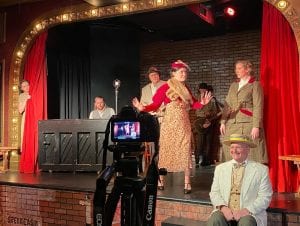
The “Big Rock” cast in rehearsal at the Speakeasy, 1818 3rd Ave., Rock Island.
“There’s either been a very small audience, with the children’s show, the miscast cabaret and ‘Rocky,’ so I didn’t find it to be too difficult or weird,” she said. “I also got into the mindset that we’re making a feature film. Even though it was 50-50, a mix of theater and film, just being in that mindset of, we’re starting this take running through the end of this page.”
“It didn’t bother me that there wasn’t an audience,” Strandin said. “The show works really well as a movie musical. I think it’s a nice story – we have shots of the band backstage. It just works really nicely.”
Tapscott and Hacker wore masks in the theater, as well as performers before they were on camera, and all felt safe.
“We kept the bubble pretty small,” Tapscott said, noting they were all previously friends and trusted each other.
“People we know are being safe and know what they’re doing,” he said. Strandin said several of the cast had prior Covid tests.
“There’s a few bits in the show we had to alter a little bit,” Tapscott said. “It feels very safe and I was never worried about it, in the environment we were in and the people we were utilizing.”
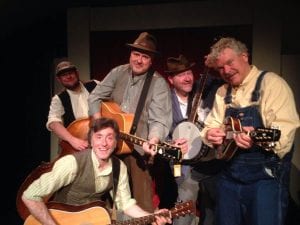
Doug Kutzli (center) in the 2014 cast of “Big Rock Candy Mountain.”
They didn’t want to use clear masks for performers, partly because “it takes people out of it,” he said. “I know that’s probably not a popular opinion, but I really don’t think it helps. It just reminds you we’re here in a pandemic and it also ages the product. Because it’s a film, I don’t want to look back and say, ‘Oh yeah, that was filmed in 2021.’
“Because if your entire cast and crew are being safe, there are ways to create art in the midst of this, in a safe way,” Tapscott said. “You just have to be responsible.”
It would have been different if they had an in-person audience, to protect the public, Strandin said. “Since we were in our little bubble we created, it felt really safe.”
The show already has a page on IMDB.com.
“Big Rock Candy Mountain” begins streaming Saturday at 7 p.m. and will be available on demand for the entire month. Proceeds go to benefit Circa
’21, The Circa ’21 Speakeasy and all of the artists on screen and off.
Tickets (starting at $10) are available now by visiting ShowTix4U.com and searching Circa ‘21 or clicking this link:
https://www.showtix4u.com/events/17497.


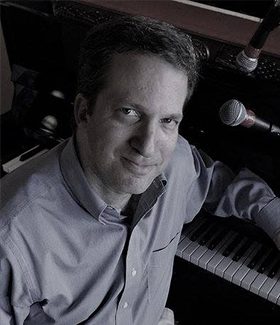
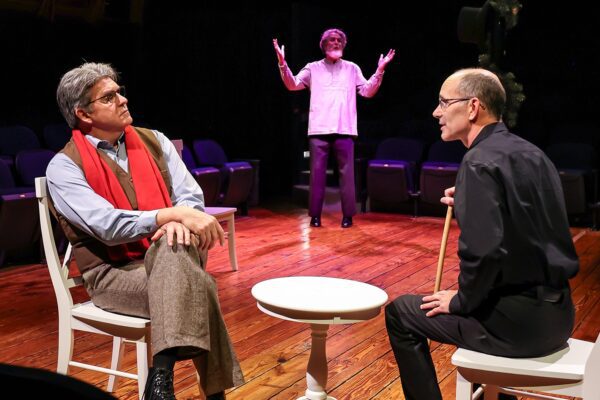
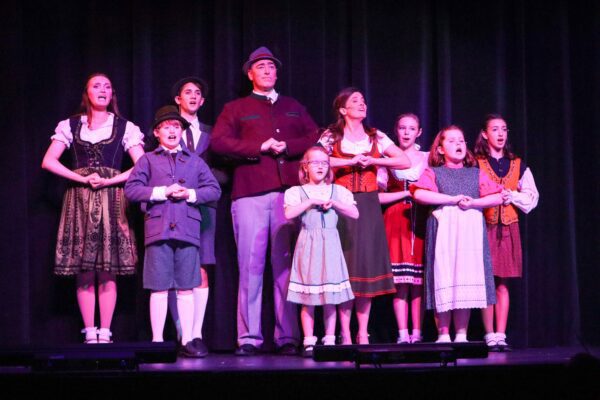








Leave a Reply
You must be logged in to post a comment.